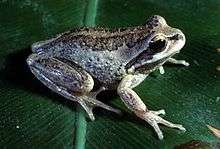Whistling tree frog
| Whistling tree frog | |
|---|---|
 | |
| Scientific classification | |
| Kingdom: | Animalia |
| Phylum: | Chordata |
| Class: | Amphibia |
| Order: | Anura |
| Family: | Hylidae |
| Subfamily: | Pelodryadinae |
| Genus: | Litoria |
| Species: | L. verreauxii |
| Binomial name | |
| Litoria verreauxii (Auguste Duméril, 1853)[2] | |
| Subspecies | |
|
Litoria verreauxii alpina (Fry, 1915) | |
| | |
| Range of Verreaux's tree frog: Litoria verreauxii verreauxii in blue, Litoria verreauxii alpina in red | |
| Synonyms | |
|
Hyla verreauxii Duméril, 1853 | |
The whistling tree frog or Verreaux's tree frog (Litoria verreauxii) is a frog occurring in Australia.[1][2]
It has been divided into two subspecies, the nominate Verreaux's tree frog (L. v. verreauxii) and the Verreaux's alpine tree frog (L. v. alpina).[1] The alpine tree frog is restricted to the southern alps of New South Wales and Victoria. Verreaux's tree frog is widespread throughout south-eastern Queensland, coastal and highland regions of New South Wales, and south-eastern Victoria.
Conservation status
Litoria verreauxii verreauxii is widespread and common across eastern Australia. L. v. alpina, though, has a very restricted range and has suffered massive declines; it is currently listed as endangered.[1]
Description
L. v. verreauxii is light brown to red brown above, with an often indistinct, broad, darker patch starting between the eyes and continuing over the back. A dark band starting at the nostril runs across the eye and down to the shoulder, underlined by a white line starting at the mouth. The thighs and backs of the legs are red with small black spots, with some larger black spots present on the fronts of the thighs.

L. v. alpina is mostly green on the dorsal surface with two brown bands running parallel to each other down the back. These bands start at the eye and are separated by a narrow band of green. The thighs and backs of the legs are the same as above. The belly of both subspecies is white. Both reach a maximum size of about 35 mm.
Ecology and behaviour
Verreaux's tree frog inhabits swamps, dam impoundments, and creeks in woodland, farmland, forest and cleared land. Males call from pond-side vegetation or from the ground all year round, but calling intensifies during autumn and spring and after rain. As its name implies, this frog makes a whistling noise.
The alpine tree frog inhabits alpine ponds and pools of creeks in moorland, alpine forest and partly cleared land. Males have a similar call as above and call from beside the breeding sites during spring and summer.
Chytrid fungus is believed to be partly responsible for the decline of the alpine subspecies.
As a pet
It is kept as a pet; in Australia, this animal may be kept in captivity with the appropriate permit.
Sources
- Anstis, M. 2002. Tadpoles of South-eastern Australia. Reed New Holland: Sydney.
- Robinson, M. 2002. A Field Guide to Frogs of Australia. Australian Museum/Reed New Holland: Sydney.
- Frog Australia Network - Alpine Tree Frog-frog call available
- Frogs Australia Network - Whistling Tree Frog-frog call available
- Article Road: List of All Frog Breeds: Things You Can Do to Ensure Your Frog Has a Long, Happy and Healthy Life: Whistling Tree Frog
- Department of Environment, Climate Change and Water, New South Wales: Amphibian Keeper's Licence: Species Lists
- All About Frogs: Species Caresheets : Information on Specific Breeds of Frogs and Toads
References
- 1 2 3 4 Jean-Marc Hero, Peter Robertson, Frank Lemckert, Graeme Gillespie, Murray Littlejohn, Peter Robertson, John Clarke (2004). "Litoria verreauxii". IUCN Red List of Threatened Species. IUCN. 2004: e.T12155A3328276. Retrieved 4 January 2016.
- 1 2 Frost, Darrel R. (2015). "Litoria verreauxii (Duméril, 1853)". Amphibian Species of the World: an Online Reference. Version 6.0. American Museum of Natural History. Retrieved 4 January 2016.
